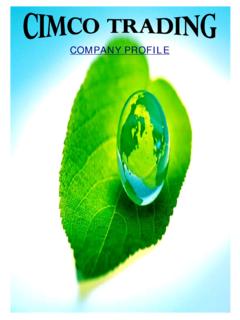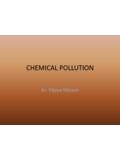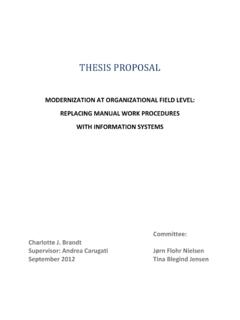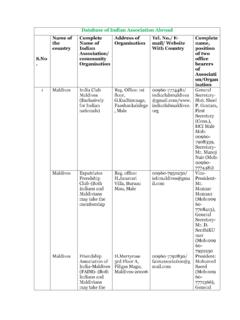Transcription of Hydrogen Technologies Safety Guide - NREL
1 nrel is a national laboratory of the Department of Energy Office of Energy Efficiency & Renewable Energy Operated by the Alliance for Sustainable Energy, LLC This report is available at no cost from the National Renewable Energy Laboratory ( nrel ) at Contract No. DE-AC36-08GO28308 Hydrogen Technologies Safety Guide C. Rivkin, R. Burgess, and W. Buttner National Renewable Energy Laboratory Technical Report nrel /TP-5400-60948 January 2015 nrel is a national laboratory of the Department of Energy Office of Energy Efficiency & Renewable Energy Operated by the Alliance for Sustainable Energy, LLC This report is available at no cost from the National Renewable Energy Laboratory ( nrel ) at Contract No. DE-AC36-08GO28308 National Renewable Energy Laboratory 15013 Denver West Parkway Golden, CO 80401 303-275-3000 Hydrogen Technologies Safety Guide C. Rivkin, R. Burgess, and W. Buttner National Renewable Energy Laboratory Prepared under Task No.
2 Technical Report nrel /TP-5400-60948 January 2015 NOTICE This report was prepared as an account of work sponsored by an agency of the United States government. Neither the United States government nor any agency thereof, nor any of their employees, makes any warranty, express or implied, or assumes any legal liability or responsibility for the accuracy, completeness, or usefulness of any information, apparatus, product, or process disclosed, or represents that its use would not infringe privately owned rights. Reference herein to any specific commercial product, process, or service by trade name, trademark, manufacturer, or otherwise does not necessarily constitute or imply its endorsement, recommendation, or favoring by the United States government or any agency thereof. The views and opinions of authors expressed herein do not necessarily state or reflect those of the United States government or any agency thereof.
3 This report is available at no cost from the National Renewable Energy Laboratory ( nrel ) at Available electronically at Available for a processing fee to Department of Energy and its contractors, in paper, from: Department of Energy Office of Scientific and Technical Information Box 62 Oak Ridge, TN 37831-0062 phone: fax: email: Available for sale to the public, in paper, from: Department of Commerce National Technical Information Service 5285 Port Royal Road Springfield, VA 22161 phone: fax: email: online ordering: Cover Photos: (left to right) photo by Pat Corkery, nrel 16416, photo from SunEdison, nrel 17423, photo by Pat Corkery, nrel 16560, photo by Dennis Schroeder, nrel 17613, photo by Dean Armstrong, nrel 17436, photo by Pat Corkery, nrel 17721. nrel prints on paper that contains recycled content. iii This report is available at no cost from the National Renewable Energy Laboratory ( nrel )
4 At List of Acronyms AHJ aut hority having jurisdiction ANSI American National Standards Institute ASM American Society of Materials ASME American Society of Mechanical Engineers ASTM American Society of Testing Materials BPV boiler and pressure vessel CFC California Fire Code CFR Code of Federal Regulations CGA Compressed Gas Association CSA Canadian Standards Association DOT Department of Transportation EPA Environmental Protection Agency H2 Hydrogen HGV Hydrogen gas vehicle IBC International Building Code IFC International Fire Code IFGC International Fuel Gas Code IMC International Mechanical Code NFPA National Fire Protection Association NIST National Institute of Standards and Technology nrel National Renewable Energy Laboratory OSHA Occupational Safety and Health Administration PEM proton exchange membrane PHA process hazard analysis SAE Society of Automotive Engineers UL Underwriters Laboratories iv This report is available at no cost from the National Renewable Energy Laboratory ( nrel ) at Table of Contents List of Figures.
5 V List of Tables .. v Introduction .. 1 General Safety Issues and Physical Properties of Hydrogen .. 3 History of Hydrogen Technologies .. 8 Discovery of Hydrogen .. 8 Hydrogen Use and Applications .. 8 Glass Manufacturing .. 8 Industrial Heat Transfer Fluid .. 9 Semiconductor Manufacturing .. 9 Ammonia Production via the Haber-Bosch Process .. 9 Hydrogen in the Petrochemical Industry .. 9 Hydrogen as a Fuel for Fuel Cells .. 10 Hydrogen Safety Incidents .. 10 Regulations, Codes, and Standards .. 12 Material Selection for Hydrogen 27 Component Selection for Hydrogen Technologies .. 29 The Permitting Process .. 31 The Permit Applicant .. 33 Permit Template and Example Permit .. 34 Template Hydrogen Dispenser Added to Existing Fueling Station .. 34 Example Permit .. 57 References .. 61 Informational Websites .. 62 Appendix A. nrel Process Hazard Analysis on a Representative Hydrogen Fueling Station .. 63 v This report is available at no cost from the National Renewable Energy Laboratory ( nrel ) at List of Figures Figure 1.
6 Timeline of codes and standards development and the codes and standards hierarchy 13 Figure 2. Schematic of a typical Hydrogen dispensing station with single dispenser with gaseous and liquid Hydrogen storage .. 60 Figure A-1. Schematic of a representative Hydrogen station .. 63 Figure A-2. nrel risk matrix .. 65 List of Tables Table 1. Comparison of Total Vehicles and Fuel Consumed by Alternative Fuel 2 Table 2. Hydrogen Properties .. 4 Table 3. DOT Hazard Classification Scheme .. 5 Table 4. Overview of Regulations, Codes, and Standards Related to Hydrogen Infrastructure Safety .. 14 Table 5. Hydrogen Dispensing Station Permitting/Potential Permits Required .. 32 Table 6. Hydrogen Dispensing Station Approvals .. 32 Table A-1. Risk Value Frequencies .. 64 Table A-2. nrel Event Probability Classification Table .. 66 Table A-3. Total Risk at Node .. 67 1 This report is available at no cost from the National Renewable Energy Laboratory ( nrel ) at Introduction The purpose of this Guide is to provide basic background information on Hydrogen Technologies .
7 It is not intended to be a comprehensive collection of Hydrogen Technologies Safety information. It is intended to provide project developers, code officials, and other interested parties the background information to be able to put Hydrogen Safety in context. For example, code officials reviewing permit applications for Hydrogen projects will get an understanding of the industrial history of Hydrogen , basic Safety concerns, and Safety requirements. What are Hydrogen Technologies ? For the purposes of this report they are processes that use or produce Hydrogen . Hydrogen can be used as fuel to power internal combustion engines or fuel cells, or as an energy carrier. Hydrogen has been used as an industrial chemical for more than a century. The Haber process for producing ammonia was developed in 1909 (Austin 1984), and the production of ammonia accounts for approximately half of the Hydrogen produced worldwide (Ramachandran and Menon 1998).
8 Approximately 40% of Hydrogen produced is used to hydrogenate petroleum products. Hydrogen is also used in several industrial processes including the following: Glass production Electronics manufacturing Coolant applications (low viscosity and high heat transfer) (Austin 1984). Safety requirements for industrial uses of Hydrogen are relatively well established. The National Fire Protection Association (NFPA) and the Compressed Gas Association (CGA) have published Safety standards that address the storage, use, and handling of Hydrogen in industrial applications that date back to the first edition of NFPA 567 (later renumbered as NFPA 50A) (National Fire Protection Association 1963) circa 1960. In the last 20 years there has been a developing interest in using Hydrogen as a fuel for fuel cells, primarily proton exchange membrane (PEM) fuel cells. PEM fuel cells are the preferred fuel cell technology for vehicles and other new applications because of their fast start-up time and low operating temperature.
9 These fuel cells are used for stationary power, primarily in backup power units, and to produce electricity for electric vehicles. Hydrogen fuel cell vehicles require fueling at intervals comparable to a gasoline powered vehicle. This fueling activity will likely require vehicle owners and operators to operate fueling equipment, although in some states all fueling is conducted by fueling station personnel. Fueling a Hydrogen fuel cell vehicle requires approximately five minutes. This exposure of the general public to Hydrogen represents a significant change in the Hydrogen risk spectrum from that of trained workers in a controlled environment handling Hydrogen . Placing Hydrogen at public fueling stations and using it in vehicles has created a need for new Safety requirements. These requirements reside in several documents and are addressed in the Regulations, Codes, and Standards section of this document. This document is organized into the following seven sections: Introduction 2 This report is available at no cost from the National Renewable Energy Laboratory ( nrel ) at Physical properties of Hydrogen History of Hydrogen Technologies Overview of regulations, codes, and standards for Hydrogen Technologies Material selection for Hydrogen Technologies Component selection for Hydrogen Technologies Overview of permitting Hydrogen Technologies .
10 Table 1 ( Census Bureau 2012) shows that approximately 174,000 gasoline equivalent gallons of Hydrogen were consumed in 2011. This is well under 1% of the total alternative fuels consumed in that year. However, this number should increase as zero-emission-vehicle mandates drive increased usage of fuel cell vehicles. This table shows that Hydrogen fuel cell vehicles are in the developmental phase. Each year has shown an increase in the number of vehicles and the amount of fuel consumed, but the totals are very small relative to other alternative fuels. Table 1. Comparison of Total Vehicles and Fuel Consumed by Alternative Fuel Type Fuel Type 2003 2004 2005 2006 2007 2008 2009 2010 2011 Compressed Natural Gas Total Vehicles 114,406 118,532 117,699 116,131 114,391 113,973 114,270 115,863 118,214 Total Fuel Consumeda 133,222 158,903 166,878 172,011 178,565 189,358 199,513 210,007 220,247 Electricity Total Vehicles 47,485 49,536 51,398 53,526 55,730 56,901 57,185 57,462 67,295 Total Fuel Consumeda 5,141 5,269 5,219 5,104 5,037 5,050 4,956 4,847 7,635 Ethanol, 85 percent Total Vehicles 176,799 211,800 246,363 297,099 364,384 450,327 504,297 618,506 862,837 Total Fuel Consumeda 26,071 31,581 38,074 44,041 54,091 62,464 71,213 90,323 137,165 Hydrogen Total Vehicles 9 43 119 159 223 313 357 421 527 Total Fuel Consumeda 2 8 25 41 66 117 140 152 174 Liquefied Natural Gas Total Vehicles 2,640 2,717 2,748 2,798 2,781 3,101 3,176 3,354 3,436 Total Fuel Consumeda 13,503 20,888 22.


















